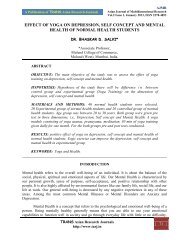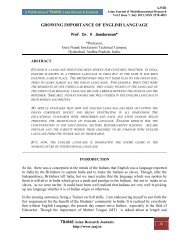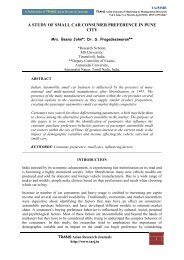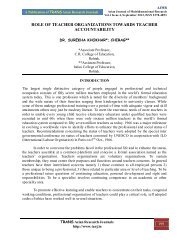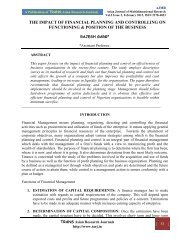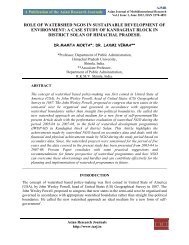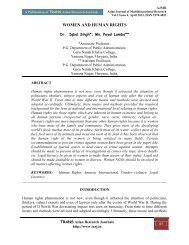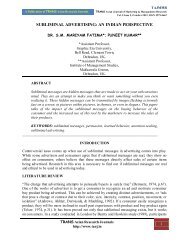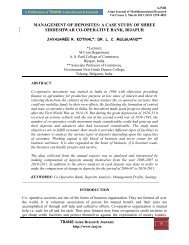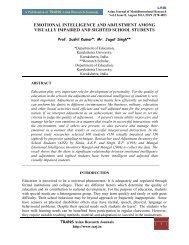3.6, Dr. Mohinder Kumar Slariya.pdf - tarj.in
3.6, Dr. Mohinder Kumar Slariya.pdf - tarj.in
3.6, Dr. Mohinder Kumar Slariya.pdf - tarj.in
You also want an ePaper? Increase the reach of your titles
YUMPU automatically turns print PDFs into web optimized ePapers that Google loves.
A Publication of TRANS Asian Research JournalsAJMRAsian Journal of Multidimensional ResearchVol.2 Issue 3, March 2013, ISSN 2278-4853HYDROELECTRIC POWER PROJECTS - A THREAT TO EXISTINGTRADITIONAL KNOWLEDGE: A STUDY OF POWER PROJECTS INRAVI BASIN IN CHAMBA DISTRICT OF HIMACHAL PRADESH INDIAABSTRACTDR. MOHINDER KUMAR SLARIYA**Associate Professor,Department of Sociology,Govt. P.G. College,Chamba, H.P., India.Dams have had serious impacts on the lives, livelihoods, culture and spiritualexistence of <strong>in</strong>digenous, tribal and illiterate people, and on the physicalenvironmental conditions and biodiversity. As far as the dam related developmentalactivities <strong>in</strong> Himachal Himalayas are concerned, they got momentum dur<strong>in</strong>g 5 th fiveyear plan and at present there are more than 400 power projects <strong>in</strong> five perennialriver bas<strong>in</strong>s spread over 55,673 sq. km geographical area. Every bas<strong>in</strong> is be<strong>in</strong>gexcessively exploited which has a considerable impact on environment andthreaten<strong>in</strong>g the lives and livelihood of the mounta<strong>in</strong> <strong>in</strong>habitants.The present paper is based on the primary research carried out <strong>in</strong> Ravi bas<strong>in</strong> of thestate. There are more than 80 power projects of different magnitudes <strong>in</strong> 40 rivuletsthat have been earmarked for the planned development and received detrimentalimpact on the available traditional knowledge because of multiple reasons.In the present paper the responsibility of hydroelectric power projects forthreaten<strong>in</strong>g the exist<strong>in</strong>g traditional knowledge which are serv<strong>in</strong>g social, cultural,spiritual, and economic aspects of communities s<strong>in</strong>ce ages but with the <strong>in</strong>stallation ofdevelopmental projects these are be<strong>in</strong>g threaten, will be analyzed which is based onorig<strong>in</strong>al micro field research carried out <strong>in</strong> the lower Himalayan Region by us<strong>in</strong>gexploratory, descriptive and participatory method of research. To analyse theimpacts on 03 commissioned power projects, 500 respondents from 55 villagesdivided <strong>in</strong> seven research cluster, selected by cluster conv<strong>in</strong>ce simple randomsampl<strong>in</strong>g methods have been used. Received data codified, <strong>in</strong>terpreted by apply<strong>in</strong>gsuitable statistical tools.KEYWORDS: hydroelectric power projects; traditional knowledge; environment,ecosystem services, impact on livelihood.__________________________________________________________________________TRANS Asian Research Journalshttp://www.<strong>tarj</strong>.<strong>in</strong>65
A Publication of TRANS Asian Research JournalsAJMRAsian Journal of Multidimensional ResearchVol.2 Issue 3, March 2013, ISSN 2278-4853INTRODUCTIONDams have had serious impacts on the lives, livelihoods, culture and spiritual existence of<strong>in</strong>digenous, tribal and illiterate people, and on the physical environmental conditions andbiodiversity. Throughout human history natural resources have been exploited to susta<strong>in</strong> grow<strong>in</strong>ghuman populations. Over the last few decades, ris<strong>in</strong>g economic growth rates <strong>in</strong> most develop<strong>in</strong>gcountries have contributed to <strong>in</strong>creas<strong>in</strong>g levels of exploitation of natural resources andenvironment degradation, which unchecked could have detrimental effects on future growthpatterns.The <strong>in</strong>crease <strong>in</strong> the world energy demand forced to <strong>in</strong>crease generation of energy from varioussources. By 2100 global mean-temperatures are forecasted to be raised by 1.4 to 5.8 degreecentigrade with an accompany<strong>in</strong>g <strong>in</strong>crease <strong>in</strong> global mean-precipitation levels [2]. The <strong>in</strong>creasedemand of energy can be met by <strong>in</strong>creas<strong>in</strong>g hydropower generation [2]. Global hydropowerproduction currently supply<strong>in</strong>g around 19 % of global demand, and is anticipated to be <strong>in</strong>creasedthree-fold <strong>in</strong> next century [1]. However, studies <strong>in</strong>dicate that decl<strong>in</strong><strong>in</strong>g river flows, as a result ofclimate changes will lead to decl<strong>in</strong><strong>in</strong>g hydropower production. Aga<strong>in</strong>st a backdrop of ris<strong>in</strong>gglobal surface temperature, Indian monsoon rema<strong>in</strong>ed unstable <strong>in</strong> the past century. Us<strong>in</strong>g dailyra<strong>in</strong> fall data, Goswami et.al (2006) observed significant rise <strong>in</strong> the frequency and magnitude ofextreme ra<strong>in</strong> and decrease <strong>in</strong> the frequency of moderate ra<strong>in</strong> <strong>in</strong> central India. Shalizi (2007),us<strong>in</strong>g a multiregional global model, simulates energy supply and demand, price trajectory andgrowth. It is shown that higher energy prices generated by rapid growth <strong>in</strong> Ch<strong>in</strong>a and India mayconstra<strong>in</strong> other countries‟ growth. Hydrological data def<strong>in</strong>ed on an annual time scale aregenerally characterized stationary unless there are large-scale climate variability, naturaldisruptions and human-<strong>in</strong>duced changes such as reservoir construction (Salas, 1993).At present, <strong>in</strong> the develop<strong>in</strong>g state of country‟s economy, requirement of electrical power forboth <strong>in</strong>dustrial and agricultural use has been <strong>in</strong>creased over the year. The Report of the Group onPower for 10 th plan estimated the need based capacity addition of 62,213 MW dur<strong>in</strong>g 11 th plan.Thus, it is necessary to commission projects to generate power to bridge the ever-<strong>in</strong>creas<strong>in</strong>g gap<strong>in</strong> demand and supply scenario. Up to March, 2010, out of total estimated potential capacity ofpower generation <strong>in</strong> India (1, 50,000 MW) only 15 per cent has been commissioned and 7 percent is on the way of its commission<strong>in</strong>g. On the one hand, it is necessary to expedite the pace ofhydro power generation and for that Govt. of India has launched a massive plan known as“Mission-2012, Power for All”, under which 50,000 MW hydroelectric powers is to be added <strong>in</strong>the exist<strong>in</strong>g power generation capacity but on the other hand, with this 22% exploitation ofpower ill-effects have become visible. Canadian group of researchers has observed that hydropower is no more pollution free; it omits greenhouse gases along with other many socioeconomic,cultural, psychological, livelihood and climatic impacts <strong>in</strong> the areas where such typesof developmental mills are planned.THE CONCEPT OF TRADITIONAL KNOWLEDGETraditional knowledge (TK) generally refer to the long-stand<strong>in</strong>g traditions and practices ofcerta<strong>in</strong> regional, <strong>in</strong>digenous, or local communities which are be<strong>in</strong>g used by them to susta<strong>in</strong> theirTRANS Asian Research Journalshttp://www.<strong>tarj</strong>.<strong>in</strong>66
A Publication of TRANS Asian Research JournalsAJMRAsian Journal of Multidimensional ResearchVol.2 Issue 3, March 2013, ISSN 2278-4853lives. TK is also encompasses the wisdom, knowledge, and teach<strong>in</strong>gs of these communities and<strong>in</strong> many cases, it has been orally transmitted from generation to generation and sometimes fromperson to person <strong>in</strong> one generation. Some forms of traditional knowledge are expressed throughstories, legends, folklore, rituals, songs, and even laws. Other forms of traditional knowledge areexpressed through different means. 1HYDROELECTRIC POWER DEVELOPMENT IN HIMACHAL PRADESHHimachal Pradesh is a mounta<strong>in</strong>ous state hav<strong>in</strong>g about thousand perennial streams which form adiverse dra<strong>in</strong>age system <strong>in</strong> the state. It has five perennial rivers of Indus water system i.e.Chenab, Yamuna, Ravi, Satluj and Beas (The fig.1 shows four major rivers of Indus watersystem i.e. Chenab, Ravi, Satluj and Beas and also show<strong>in</strong>g three major projects with longreservoirs <strong>in</strong> Himachal Pradesh). Out of these bas<strong>in</strong>s Beas, Satluj and Ravi bas<strong>in</strong>s contributesmore than 72 % potential capacity out of 25000 MW assessed potential capacity of hydroelectricpower generation <strong>in</strong> Himachal Pradesh.FIG.1 SHOWING FOUR MAJOR RIVERS OF HIMACHAL PRADESH WHICH HAVEBEEN TARGETED FORHYDROELECTRIC POWER DEVELOPMENTTRANS Asian Research Journalshttp://www.<strong>tarj</strong>.<strong>in</strong>67
A Publication of TRANS Asian Research JournalsAJMRAsian Journal of Multidimensional ResearchVol.2 Issue 3, March 2013, ISSN 2278-4853HYDROELECTRIC POWER PROJECTS IN RAVI BASINRavi has total catchments area of 5,451 sq. kilometers and 154 sq. km <strong>in</strong> Himachal Pradesh. Thisbas<strong>in</strong> lies between the PirPanjal and Dhauladhar ranges of Lesser Himalayas and falls <strong>in</strong> southwestpart of the state. Fig-2 shows power projects <strong>in</strong> ravi bas<strong>in</strong> which have been studied by theresearcher. The potential capacity of Ravi has been assessed 2301.5 MW; out of which 1038.5MW has been commissioned so far through four commissioned power projects <strong>in</strong> Chambadistrict i.e. Bairasuil (198 MW), Chamera-I (540 MW) and Chamera-II (300 MW). In otherwords it can be stated that this bas<strong>in</strong> has been heavily targeted for the hydroelectric powerdevelopment s<strong>in</strong>ce 1980s with the <strong>in</strong>stallation of NHPC‟s first hydroelectric power generationplant with the name of BairaSuil Hydroelectric power project. After this power project Chameraseries of projects have been started. In 1990s Chamera stage I, <strong>in</strong> 2000 Chamera-II and Chamera-III (was targeted to be completed by the end of 2010, but still required more months) havecontributed considerably to change the ecology and climatic conditions of the whole bas<strong>in</strong>.Along with these, bas<strong>in</strong> has experienced a major jolt of development named as The<strong>in</strong> Dam,which is situated at the boarder of Himachal Pradesh, Punjab and Jammu and Kashmir. Table 1present exist<strong>in</strong>g hydropower projects of Ravi Bas<strong>in</strong> and Table 2 presents proposed hydropowerprojects. Table 3 presents route detail of Ravi River <strong>in</strong> Himachal Pradesh.FIG. 2 : BLUE COLOUR LINES IN MAP SHOWING RAVI BASIN AND RED DOTSCOMMISSIONED POWER PROJECTS IN RAVI BASINTRANS Asian Research Journalshttp://www.<strong>tarj</strong>.<strong>in</strong>68
A Publication of TRANS Asian Research JournalsAJMRAsian Journal of Multidimensional ResearchVol.2 Issue 3, March 2013, ISSN 2278-4853TABLE 1: SHOWING THE POWER PROJECTS ***ON RAVI BASINSr.No.Name of PowerProjectName of River/nallahClassificationInstallationCapacity (<strong>in</strong> MW)1. Chamera-I* Ravi Large 540.002. Chamera-II * Ravi Large 300.003. Chamera-III Ravi Large 231.004. BairaSuil * BairaSuil Large 198.005. Bhuri S<strong>in</strong>gh * SaalNala Micro 000.456. Tundah-I Tundahnallah Small 015.007. Tundah-II Tundahnallah Small 030.008. Bharmour Micro Budhil Micro 000.029. Garola Garolanallah Micro 000.0510. Holi Hol<strong>in</strong>allah Small 003.0011. Sal Stage –I Saalnallah Small 008.2512. Sal Stage –II Saalnallah Small 002.2513. Budhil Budhilnallah Medium 081.0014 Bharmour Budhilnallah Medium 045.0015. Harsar Budhilnallah Medium 060.0016. Kugti Budhilnallah Medium 045.0017. Kutehr Ravi Large 360.0018. S<strong>in</strong>di Ravi Medium 120.0019. Bara Bangal Ravi Medium 160.0020. The<strong>in</strong> Dam** Ravi &Sewa Large 600**TRANS Asian Research Journalshttp://www.<strong>tarj</strong>.<strong>in</strong>69
A Publication of TRANS Asian Research JournalsAJMRAsian Journal of Multidimensional ResearchVol.2 Issue 3, March 2013, ISSN 2278-4853*Indicates power projects <strong>in</strong> operation <strong>in</strong> Chamba district.**The<strong>in</strong> dam (Maharaja Ranjeet S<strong>in</strong>ghHE Power project with 600 MW Capacity at ShahpurKandi near Pathankot (Punjab) situated at<strong>in</strong>terstate boarder of Jammu & Kashmir, Himachal Pradesh and Punjab.***maximum m<strong>in</strong>i/microprojects <strong>in</strong> ravi bas<strong>in</strong> (45) have not <strong>in</strong>cluded <strong>in</strong> this table.TABLE 2: EXISTING OPERATIONAL HYDROELECTRIC POWER PROJECTS ONRAVI BASINSr. No Name of PowerProjectName of River/nallahClassificationInstallationCapacity (<strong>in</strong> MW)1. Chamera-I Ravi Large 540.002. Chamera-II Ravi Large 300.003. BairaSuil BairaSuil Large 198.004. Bhuri S<strong>in</strong>gh SaalNala Micro 000.455. The<strong>in</strong> Dam * Ravi &Sewa Large 600*Source: Author‟s compilation from different sources (<strong>Slariya</strong> 2008).*The<strong>in</strong> dam (Maharaja Ranjeet S<strong>in</strong>gh HE Power project with 600 MW Capacity atShahpurKandi near Pathankot (Punjab) situated at <strong>in</strong>terstate boarder of Jammu & Kashmir,Himachal Pradesh and Punjab.TABLE 3 PRESENT STATUS OF RAVI IN HIMACHAL PRADESH: THREATEN THETRADITIONAL KNOWLEDGE OF MILLINGRavi <strong>in</strong> TunnelRavi <strong>in</strong> reservoirTotal (tunnel +reservoir)Total length of Ravi <strong>in</strong> Himachal Pradesh (Road distancefrom TRT Khairi to Bagga dam)Ravi <strong>in</strong> its natural route(Total length -Reservoir length -Tunnel length)In the upstream of chamera-II, with the completion ofChamera-III, 25 km Ravi will be diverted <strong>in</strong>to 15.995 kmlong power tunnel with 6 edit tunnels19.38 KM32.06 KM51.44 KM73.00KM21.57 KMTRANS Asian Research Journalshttp://www.<strong>tarj</strong>.<strong>in</strong>70
A Publication of TRANS Asian Research JournalsAJMRAsian Journal of Multidimensional ResearchVol.2 Issue 3, March 2013, ISSN 2278-4853Hydroelectric Power Projects <strong>in</strong> bas<strong>in</strong> catchment area are threaten<strong>in</strong>g/have threatened exist<strong>in</strong>gtraditional knowledge of mill<strong>in</strong>g, because of follow<strong>in</strong>g probable reasons:1. 100 kilometers reservoirs of commissioned projects like; ShahpurKandi (125 MW), The<strong>in</strong>Dam (600 MW, with Catchments area of 6086 sq km and reservoir of 87 sq. km), Chamera-I(540 MW) Hydro Power Project and Chamera-II (300 MW) Hydro Power Project2. Tunnelization of Ravi <strong>in</strong> 19.38 kms because of construction of Chamera-I and Chamera-IIpower projects owned by NHPC and 15.995 km long tunnel with 6 edit tunnels of chamera-III (231 MW) to be completed by the end of 2011, total tunnel<strong>in</strong>zation is 35.033 kms becauseof construction of three power projects3. <strong>Dr</strong>y patches of Ravi <strong>in</strong> two projects more than 22 kms <strong>in</strong> the downstream of chamera-I andII. In the upstream of chamera-I where Ravi seen occasionally particular <strong>in</strong> the summer &w<strong>in</strong>ter season and now add<strong>in</strong>g more than 25 km patch of chamera-III and total dry patch is22+25=47 km out of 65 km of Ravi and this dry patch has closed traditional water mills andput an end the traditional occupation based on TK of the people who are liv<strong>in</strong>g <strong>in</strong> the vic<strong>in</strong>ityof this patch of 47 km.FIGURE 3: SHOWING LAYOUT PLAN OF CHAMERA-I BECAUSE OF WHICH 12KM LONG RAVI GOT DRIED IN THE DOWNSTREAM OF THE DAM AND CLOSED20 WATER MILLS AND IN THE UPSTREAM OF DAM, 29 KM LONG RESERVOIRAFFECT THE PEOPLE OF MORE THAN 50 VILLAGES IN BOTH SIDE OF THEBASIN AND CLOSED MORE THAN 40 WATER MILLSTRANS Asian Research Journalshttp://www.<strong>tarj</strong>.<strong>in</strong>71
A Publication of TRANS Asian Research JournalsAJMRAsian Journal of Multidimensional ResearchVol.2 Issue 3, March 2013, ISSN 2278-4853FIGURE 4: SHOWING DIVERSION TUNNEL OF CHAMERA-II POWER PROJECTWHICH IS RESPONSIBLE FOR 15 KM DRIED RAVI AND AGE-OLD OCCUPATIONPROFESSION OF WATER MILLING IN THIS PATCH IN THE DOWNSTREAM OFDAM HAS BEEN SNATCHED AND IN 2.6 KM LONG RESERVOIR IN THEUPSTREAM OF DAM HAS CLOSED 5 WATER MILLS. THE WATER MILLS IN THISAREA ARE RESPONSIBLE TO MEET OUT THE MILLING REQUIREMENT OFMORE THAN 10 VILLAGES IN UP-STREAM AS WELL AS IN THE DOWNSTREAMAND SNATCHED THE AGE-OLD TRADITIONAL KNOWLEDGE OF MILLINGAuthorities claim the restoration of affected millers, but that restoration is physical and physicalrestoration cannot revive the age-old traditional knowledge of mill<strong>in</strong>g and the com<strong>in</strong>g generationwill never experience and see this profession aga<strong>in</strong>.STATUS OF TRADITIONAL KNOWLEDGE OF WATER-MILLING IN RAVI BASINOF CHAMBA DISTRICT OF HIMACHAL PRADESH, INDIATraditional Knowledge (TK) generally refers to the long-stand<strong>in</strong>g traditions and practices ofcerta<strong>in</strong> regional, <strong>in</strong>digenous, or local communities. In hills TK is prom<strong>in</strong>ently be<strong>in</strong>g used forlivelihood and it has vital role to play <strong>in</strong> the daily activities of the people. These are thedeterm<strong>in</strong>ant of village life and are symbols of self-sufficiency and carrier of “Hatt andGharat”culture of hills. Water-mill<strong>in</strong>g as a profession can be traced s<strong>in</strong>ce the <strong>in</strong>ception ofcivilization and <strong>in</strong> ravi bas<strong>in</strong> there is no any written record available regard<strong>in</strong>g the existence ofthis profession. But as per the version of the people recorded by the researcher, this traditionalknowledge of mill<strong>in</strong>g is available approximately more than 1500 years, when the settled humanlife started <strong>in</strong> the hills and at that time it was the only source to gr<strong>in</strong>d the gra<strong>in</strong> and convert it <strong>in</strong>toflour to make roti and Chapati to eat and <strong>in</strong> this way hilly people rear their families. At that timethere were no shops from where they can purchase and moreover at that time Bartarsystem ofTRANS Asian Research Journalshttp://www.<strong>tarj</strong>.<strong>in</strong>72
A Publication of TRANS Asian Research JournalsAJMRAsian Journal of Multidimensional ResearchVol.2 Issue 3, March 2013, ISSN 2278-4853service was prom<strong>in</strong>ent and people had no money to purchase anyth<strong>in</strong>g out of the village. On thesmall rivulet/nalla one man called Gharati (miller) by us<strong>in</strong>g locally available material constructwater mill and gr<strong>in</strong>d the gra<strong>in</strong> of the village and rear the whole village population as well as bycharg<strong>in</strong>g Bhara (cost of gr<strong>in</strong>d<strong>in</strong>g) <strong>in</strong> form of small amount of gra<strong>in</strong>, also rear his family. In thisway,people this TK available with the hilly people are liv<strong>in</strong>g with peace and without any demandfrom anyone s<strong>in</strong>ce ages. They were self-sufficient and self-reliant. But with the com<strong>in</strong>g uphydroelectric power projects <strong>in</strong> ravi bas<strong>in</strong>, this TK of mill<strong>in</strong>g is affected considerably andparticularly, the water mills available on the small rivulets existed <strong>in</strong> the remotest part of thedistrict/ ravi bas<strong>in</strong>. Because of the construction of more than 50 projects on differentstream/rivulets/nallas of ravi bas<strong>in</strong>, this TK of mill<strong>in</strong>g is badly affected. There are 49rivulets/rav<strong>in</strong>e/nallas <strong>in</strong> ravi bas<strong>in</strong> <strong>in</strong> chamba district of HP. Maximum watermills are available<strong>in</strong> the small rivulets/nallas as compared to ma<strong>in</strong> ravi because of many reasons. Therefore thepower projects of small/medium/m<strong>in</strong>i and micro categories are mostely affect<strong>in</strong>g water-mills. Asthe conservative estimate on the basis of discussion and physical verification at some po<strong>in</strong>ts byresearcher, follow<strong>in</strong>g are the water mills which are at present available <strong>in</strong> ravi bas<strong>in</strong> and areeither affected or to be affected because of the <strong>in</strong>stallation of power projects:TABLE 4: SHOWING WATER MILLS IN SUB-BASINS OF RAVI BASIN*Sr.No.Name of Subbas<strong>in</strong>No. of water-millsDescription of catchment area of subbas<strong>in</strong>sof Ravi bas<strong>in</strong>TotalWater-millsWatermillstotallyf<strong>in</strong>ishedNo. ofPanchayatsNo. ofVillagesPopulation(approximately)1. Saal 64 07 09 70 90002. Chamera-Icatchment3. Chamera-IIcatchment4. Chanju-Charda**40 22 10 58 800010 04 5 13 200055 -- 6 40 70005. Tarela 52 45 6 42 60006. Devi-Kothi** 17 -- 3 20 15007. Kugti** 10 -- 2 06 07508. Holi 45 06 11 53 6500TRANS Asian Research Journalshttp://www.<strong>tarj</strong>.<strong>in</strong>73
A Publication of TRANS Asian Research JournalsAJMRAsian Journal of Multidimensional ResearchVol.2 Issue 3, March 2013, ISSN 2278-48539. Biara 19 09 6 35 600010. Suil 80 04 13 73 9500Total 392 97 71 410 56250* data based on observation and physical verification by the researcher dur<strong>in</strong>g filed visits and asper the response got from the respondents and responsible people of the area like, memberzilaparishad, pradhan, member block development simiti dur<strong>in</strong>g 2009-2011.**water mills not f<strong>in</strong>ished because power projects <strong>in</strong> these sub-bas<strong>in</strong>s are either <strong>in</strong> plann<strong>in</strong>g ordevelop<strong>in</strong>g stage and not commissioned yet.As data <strong>in</strong>dicated <strong>in</strong> the table that there are approximately 392 water mills <strong>in</strong> ravi bas<strong>in</strong>. Thesewater mills are the carrier of age-old traditional knowledge of mill<strong>in</strong>g and carrier of „Hatt andGharat Culture‟ of hills. There are 10 sub-bas<strong>in</strong>s of ravi bas<strong>in</strong> compris<strong>in</strong>g of more than 50rivulets/riv<strong>in</strong>es/nallas spread<strong>in</strong>g more than 70 panchayats (village level adm<strong>in</strong>istrative units),which can further expended <strong>in</strong> 410 villages with approximate population of more than 56,000.People of more than 70 panchayats of more than 400 villages are us<strong>in</strong>g this knowledge to susta<strong>in</strong>their lives and livelihood s<strong>in</strong>ce time memorial. Out of 392 water-mills 97 have been f<strong>in</strong>ishedtotally because of hydro-power generation, the number would <strong>in</strong>creas<strong>in</strong>g if an <strong>in</strong>tensive researchis <strong>in</strong>itiated and the status of water mills can be checked as prepared. The rema<strong>in</strong><strong>in</strong>g water millsare also struggl<strong>in</strong>g for their existence because of flow of water release after the generation ofhydro power and the operation of these water mills are depends on water available <strong>in</strong> the stream.Water mills are work<strong>in</strong>g as composite unit compris<strong>in</strong>g of wooden woven and corn press<strong>in</strong>gmach<strong>in</strong>es (these mach<strong>in</strong>es are locally made out of local material and meet<strong>in</strong>g the needs of thelocal people).But with the com<strong>in</strong>g up of hydroelectric power projects s<strong>in</strong>ce 5 th five year plan i.e. 1985,rivers/rivulets/nallas are heavily targeted for such types of planned development and today thesituation is alarm<strong>in</strong>g. The policy makers planned such types of developmental <strong>in</strong>itiatives withoutassess<strong>in</strong>g non-material assets of the people who are liv<strong>in</strong>g <strong>in</strong> the vic<strong>in</strong>ity of proposeddevelopmental activities. Specifically speak<strong>in</strong>g the traditional knowledge available with thepeople has not assessed and never taken <strong>in</strong>to consideration while prepar<strong>in</strong>g impact report. In thewhole Ravi bas<strong>in</strong> more than 50 power projects of different magnitude have been either <strong>in</strong>stalledor yet to be <strong>in</strong>stalled and this number of power projects have affected the traditional occupationof mill<strong>in</strong>g and put an end traditional knowledge based age-old profession of mill<strong>in</strong>g.IMPACT ON TRADITIONAL OCCUPATION OF MILLINGThe <strong>in</strong>digenous water mills have been closed because of the non-availability of water <strong>in</strong> smallrivulets (nallas). Once people gr<strong>in</strong>d their food gra<strong>in</strong> <strong>in</strong> these water mills, now gr<strong>in</strong>d <strong>in</strong> electricgr<strong>in</strong>ders (chakki). Initially it was free of cost; only a small amount of gr<strong>in</strong>ded gra<strong>in</strong> was given toTRANS Asian Research Journalshttp://www.<strong>tarj</strong>.<strong>in</strong>74
A Publication of TRANS Asian Research JournalsAJMRAsian Journal of Multidimensional ResearchVol.2 Issue 3, March 2013, ISSN 2278-4853the gr<strong>in</strong>der (Gharati), but now the cost of gr<strong>in</strong>d<strong>in</strong>g <strong>in</strong> terms of gr<strong>in</strong>ded gra<strong>in</strong> or money is veryhigh. It has disturbed the self-sufficient and self-reliant status of Indian village community. Now,new electric gr<strong>in</strong>ders (chakkis) are dependent on the supply of electricity while the traditionalmethod of gr<strong>in</strong>d<strong>in</strong>g <strong>in</strong> the form of gharatswas based on the flow of water. This replacement oftraditional method by modern method because of these hydroelectric developments <strong>in</strong> the Ravibas<strong>in</strong> has disturbed the Hatt and Gharat Culture of Indian village community. Mean<strong>in</strong>g thereby,Hatt (shops) and Gharat (water mills) are focal chat/discussion po<strong>in</strong>ts/places where all issues ofvillages are discussed <strong>in</strong> natural sett<strong>in</strong>g. There are more than 80 water mills (as shown <strong>in</strong> thefigure-3) and carr<strong>in</strong>g age old Hatt and Gharat Culture of hills s<strong>in</strong>ce ages and meet<strong>in</strong>g the floorgr<strong>in</strong>d<strong>in</strong>g need of more than 25 villages with more than 6,000 population. Now, because of<strong>in</strong>stallation of proposed small power projects these water mills are go<strong>in</strong>g to be closed.FIGURE-3 SHOWING EXISTING WATER MILL IN RAVI BASIN INCHAMBADISTRICT OF HPVILLAGEBASED ECO-TOURISM: AN ALTERNATIVEFor hydro-power generation the age-old traditions and TK which is govern<strong>in</strong>g/shap<strong>in</strong>g the livesand determ<strong>in</strong><strong>in</strong>g the livelihood of the people of the area is be<strong>in</strong>g snatched. In some cases it hasTRANS Asian Research Journalshttp://www.<strong>tarj</strong>.<strong>in</strong>75
A Publication of TRANS Asian Research JournalsAJMRAsian Journal of Multidimensional ResearchVol.2 Issue 3, March 2013, ISSN 2278-4853been snatched (97 water-mills to-date have been snatched) and the com<strong>in</strong>g generation is notgo<strong>in</strong>g to see these water-mills aga<strong>in</strong> and they cannot have flour gr<strong>in</strong>ded by these gr<strong>in</strong>d<strong>in</strong>g mills(water-mills). On the one hand the policy makers and different organisations at state, nationaland <strong>in</strong>ternational level are advocates to conserve and protect the TK available <strong>in</strong> any form and onthe other we are los<strong>in</strong>g everyth<strong>in</strong>g <strong>in</strong> the name of development. As a concrete solution of theproblem I advocate to air mark any sub-bas<strong>in</strong> for heritage tourism po<strong>in</strong>t where all availabletraditional knowledge based th<strong>in</strong>gs are protected under the direct control of the government. Thenatural beauty of this bas<strong>in</strong> is go<strong>in</strong>g to be disturbed by the serials of power projects. There isanother untouched and unexploited source of hydro electricity generation. Whole bas<strong>in</strong> isagriculture dom<strong>in</strong>ated and self-dependent. The traditional knowledge of mill<strong>in</strong>g can be protectedalong with power generation and whole area can be developed as „village based tourism‟ area.Accord<strong>in</strong>g to an rough estimate made by HESCO there are nearly 50,000 water mills <strong>in</strong> theentire Himalayas region from the Northeastern states to J&K, which can produce 2500 MW,assum<strong>in</strong>g each generates 5 KW, that is a cash generation of Rs. 1200 million per hour and givesdirect employment to 1,50,000 people assum<strong>in</strong>g three persons per water mill.I am talk<strong>in</strong>g about one sub-bas<strong>in</strong> of ravi i.e. saal, which can be developed as heritage tourismarea along with power generationand flour gr<strong>in</strong>d<strong>in</strong>g by provid<strong>in</strong>g direct employment to a numberof local youth and will also preserve the pahari (hills) way of life (predom<strong>in</strong>ated by the TK)which revolves around the water mills. Above all, all this can happen without disturb<strong>in</strong>g theenvironment, ecosystem and without disturb<strong>in</strong>g the lives and livelihood of the people. Water millcover and protected the cluster of trees which strengthen the soil and the problem of soil erosionof the Saal river can be solve and furthermore it will excel the natural beauty of the area whichattracts the tourists along with electricity generation.Accord<strong>in</strong>g to an estimate made by gram panchayat and ZilaParishad member of saal valley thatthere are 49 functional water mills <strong>in</strong> Zaderanalla on which Hul HEP project is proposed to be<strong>in</strong>stalled and 35 water mills <strong>in</strong> Sahonalla which became Saal at Cham<strong>in</strong>u village. Accord<strong>in</strong>g to<strong>Dr</strong>. Anil Joshi of HESCO a water mill can produce 5-10 KW power after slight modifications <strong>in</strong>the traditional water mills with little specifications with <strong>in</strong> the small expenditure of 35-45thousand per water mill. There are 84 water mills <strong>in</strong>saalsub-bas<strong>in</strong>, which can be modernized andset an example for the whole district as well as for the state.There are 84 water mills <strong>in</strong> the area, which can produce 420 KW power assum<strong>in</strong>g 5 KW perwater mill. 420 units electricity can be generated per hour through which Rs. 420 x2.40=1008=00 per hour can be earn, this amount goes to Rs. 24,192=00 per day and Rs.72,576=00 per month and Rs. 8,70,912=00 per year additional along with gr<strong>in</strong>d<strong>in</strong>g. It will givedirect employment to at least three persons per water mill (84x3=252 persons) and <strong>in</strong>directly it<strong>in</strong>creases manifolds.This all can be done without disturb<strong>in</strong>g anyth<strong>in</strong>g. The conflict between development and thenative people can be resolved easily. There will be no disturbance <strong>in</strong> the physical environment ofthe seismically sensitive zone-V, by adopt<strong>in</strong>g such type of approaches we can strengthen thephysical environment and the possibility of the earthquakes <strong>in</strong> the region can be ruled out to agreater extent. The possibility of unrest ness among the youth of the area can be ruled out easilyTRANS Asian Research Journalshttp://www.<strong>tarj</strong>.<strong>in</strong>76
A Publication of TRANS Asian Research JournalsAJMRAsian Journal of Multidimensional ResearchVol.2 Issue 3, March 2013, ISSN 2278-4853by not snatch<strong>in</strong>g their traditional occupation of agriculture, which largely depends on the localkuhul (canal). The small patches of local varieties of trees around the water mills will <strong>in</strong>creasesthe natural beauty of the area and <strong>in</strong>vites tourists as well as researchers from far of places.Today, we need to th<strong>in</strong>k aga<strong>in</strong> on the policies, which are be<strong>in</strong>g made for the hills because all theexist<strong>in</strong>g policies for the development of the hills are full of conflicts among the development andnative people. We should th<strong>in</strong>k and make policies by tak<strong>in</strong>g local circumstances <strong>in</strong>toconsideration, so that this conflict can be resolved and the true fruits of development can beenjoyed. The feel<strong>in</strong>g of <strong>in</strong>security among the local people of be<strong>in</strong>g disturb by any developmentalactivities must not be there. If they disturbed by any developmental activity they must resettle <strong>in</strong>prior conditions, conducive for liv<strong>in</strong>g, before start<strong>in</strong>g developmental project. In the policiesm<strong>in</strong>imum disturbance to eco- system as well as to social system must be <strong>in</strong>sured. For all thatwhat we need, a strong political will and the will power of the local people, because it is thepolitical will that may brought any type of change <strong>in</strong> society and the political will can beimplemented only through strong will power of the local people.FINAL COMMENTSThe researcher is not aga<strong>in</strong>st the <strong>in</strong>stallation of power projects but these must be eco-friendly andsusta<strong>in</strong>able <strong>in</strong> nature and there must be susta<strong>in</strong>able improvement of human welfare. This means asignificant advancement of human development, which is economically viable, socially equitableand environmentally susta<strong>in</strong>able. If the dams are the best way to achieve this goal, then deservethe full support of the researcher. The local issues must be taken <strong>in</strong>to consideration properly andwith true spirit, not <strong>in</strong> paper and must not be engulfed by the red tapism of the Indianbureaucracy. The policies should be framed <strong>in</strong> such a way by visit<strong>in</strong>g local sites so that theproportionate balance between biotic and abiotic components of the environment can bema<strong>in</strong>ta<strong>in</strong>ed and the potential capacity of Ravi can be utilized properly. Before sanction<strong>in</strong>g anyother power project for Ravi bas<strong>in</strong> the World Commission on Dams recommendations must betaken <strong>in</strong>to consideration, which has stressed four fundamental values regard<strong>in</strong>g the dam build<strong>in</strong>g,these are; equity, efficiency, participatory decision-mak<strong>in</strong>g, susta<strong>in</strong>ability and accountability.Everyth<strong>in</strong>g can be generated but water cannot. Once it is lost it will be lost forever, it cannot begenerated. So the need of the hour is to use this wonderful gift of god to meet our need not togreed. We must keep ourselves away from the natural cycle of the water and should not disturb it<strong>in</strong> the name of so called development. We must keep <strong>in</strong> m<strong>in</strong>d that Nature can live without manbut man cannot.BIBLIOGRAPHY1. Acharya, Deepak and ShrivastavaAnshu (2008): Indigenous Herbal Medic<strong>in</strong>es: TribalFormulations and Traditional Herbal Practices, Aavishkar Publishers Distributor, Jaipur-India. ISBN 9788179102527. pp 4402. Council of Power Utilities <strong>in</strong> India (2000). New Delhi: Govt. of India.TRANS Asian Research Journalshttp://www.<strong>tarj</strong>.<strong>in</strong>77
A Publication of TRANS Asian Research JournalsAJMRAsian Journal of Multidimensional ResearchVol.2 Issue 3, March 2013, ISSN 2278-48533. Devon G. Peña, "Glossary." Mexican Americans and the Environment. Tucson: TheUniversity of Arizona Press, 2005. 198.4. Economic Survey of Himachal Pradesh (2003-04). Shimla: Department of Economics &Statistics, Govt. of H.P.5. Global Possible Conference (1984); The Global Possible: Resources, Development, & theNew Century, Wash<strong>in</strong>gton: World Resources Institute.6. Harnot,S.R. &Verma, R.P. (2004). Himachal At a Glance,Shimla: M<strong>in</strong>erva Book House.7. L<strong>in</strong>k<strong>in</strong>g Science and Local Knowledge8. OFFICE OF THE UNITED NATIONS HIGH COMMISSIONER FOR HUMAN RIGHTS(2007). "Indigenous peoples" (WEB PAGE). Office of the United Nations HighCommissioner of Human Rights. Geneva. Archived from the orig<strong>in</strong>al on 2007-11-07.http://web.archive.org/web/20071107144031/http://www.ohchr.org/english/issues/<strong>in</strong>digenous/. Retrieved 2007-11-29.9. Prasad, Y. (2000). Conventional Source of Energy - Need for Susta<strong>in</strong>ed Emphasis on HydroElectric Development, Water Power, Vol.2, No.8, June 2000, Faridabad: NHPC.10. Research article by Terra Nuova on "Preservation and ma<strong>in</strong>tenance of biological diversityrelated knowledge of <strong>in</strong>digenous diversity and local communities with traditional lifestylesBony Forest, Ijara District"11. Roy, A. (1999). The Greater Common Good, Bombay: India Book Distributors Ltd.12. <strong>Slariya</strong>, <strong>Moh<strong>in</strong>der</strong> (2007), “A Study of Impacts of Hydroelectric Power Projects on Ecologyand Society <strong>in</strong> Chamba District of Himachal Pradesh.” Ph.D. thesis submitted to MJPRohilkhand University, Bareilly; Uttar Pradesh; India.13. The CBD: Local knowledge systems at the heart of <strong>in</strong>ternational debates, B. Roussel,Synthèse, n° 2, 2003, Institute for Susta<strong>in</strong>able Development and International Relations. [1]14. The H<strong>in</strong>du (Chennai, India). "IPRs policy proposes „knowledge commons'". 28 June 2008.http://www.h<strong>in</strong>du.com/2008/06/28/stories/2008062856600100.htm.15. The Report of the Group on Power for 10th Five Year Plan and projections for 11th Five yearPlan; New Delhi, Government of India16. Traditional ecological knowledge handbook : a tra<strong>in</strong><strong>in</strong>g manual and reference guide fordesign<strong>in</strong>g, conduct<strong>in</strong>g, and participat<strong>in</strong>g <strong>in</strong> research projects us<strong>in</strong>g traditional ecologicalknowledge / prepared by Rita A. Miraglia. Hosted by Alaska State Publications Program.17. Tyndall Centre for Climate Change Research, Norwich, UK18. United Nations University's "Traditional Knowledge Bullet<strong>in</strong>"19. WORLD INTELLECTUAL PROPERTY ORGANISATION (2001).TRANS Asian Research Journalshttp://www.<strong>tarj</strong>.<strong>in</strong>78



